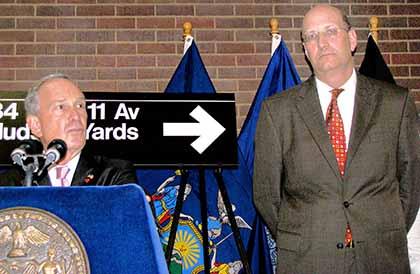By Philip Newman
Amid thunderous grinding and clouds of dust, a huge boring machine crashed through a wall of rock to complete the final tunneling for an extension of the No. 7 subway, the way to work for thousands of Queens commuters.
Both Metropolitan Transportation Authority Chairman Jay Walder and Mayor Michael Bloomberg were elated — the mayor because it was a goal of his administration and Walder because it makes possible expansion at a time of economic hardship when the city is footing the bill.
Both officials spoke at a news conference at the Port Authority Bus Terminal last Thursday.
New York City will pay the $2.1 billion bill for the extension past Times Square to 11th Avenue and 34th Street.
“For decades, people have talked about the Hudson Yards on Manhattan’s far West Side as a potential opportunity to provide a new office space, housing, parks and jobs adjacent to the world’s premier business district,” Bloomberg said. “But nothing ever happened. We’re acting to make sure that it does.”
He added, “This is one project that is on-time and on-budget.”
Walder told people assembled in corner of the Port Authority bus terminal that “this marks the final leg of the second of two, 1,000-ton tunnel boring machines that have mined more than a combined 9,300 feet to reach this point. It’s a major milestone for a project that has been emblematic of the strong partnership between agencies to complete a project that will increase capacity within our transit system and help redevelop a vital part of our city that will spur future growth.”
The extension of the No. 7 line is scheduled to be completed in December 2013.
The West Side Yards is the largest, undeveloped single area left in Manhattan and was designed to accommodate a giant platform above railroad tracks, which is used for storage of Long Island Rail Road train cars.
The area is projected to be home to 12 million square feet of commercial and residential development, including 5,000 affordable and market-rate residences in nine residential buildings, three corporate headquarters sites, a retail complex including a department store, a 300-room convention hotel, cultural facilities and a new 750-seat public school as well as 12 acres of public open space. The plan for the project was devised by the Hudson Yards Development Corp., a city agency, with contributions from a variety of architectural firms for various aspects of the proposed construction.
Madison Square Garden briefly considered moving to the area and the area was once suggested as a site for a West Side stadium for the New York Jets.
Originally, the No. 7 extension plan included a station at 10th Avenue and 41st Street that was abandoned as too expensive, but the idea has again emerged as possible.
“We did not have the money originally,” Bloomberg said. “Now we want to restore the 41st Street station so everybody should call or otherwise make themselves heard to their legislators. Tell them we need the money.”
Reach contributing writer Philip Newman by e-mail at timesledgernews@cnglocal.com or phone at 718-260-4536.



































